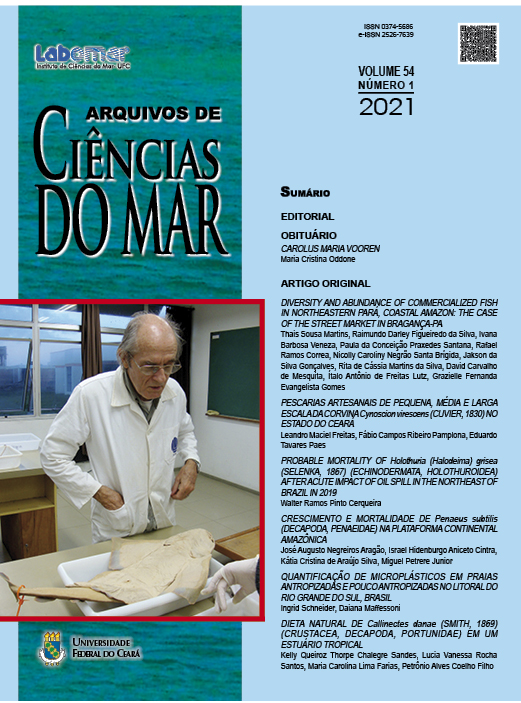REPRODUCTION AND RECRUITMENT OF THE BROWN SHRIMP Penaeus subtilis IN THE AMAZON RIVER CONTINENTAL SHELF
Reprodução e recrutamento do camarão-rosa Penaeus subtilis na plataforma continental amazônica
DOI:
https://doi.org/10.32360/acmar.v54i1.41690Abstract
This paper analyzes the pattern of the reproduction and recruitment of the pink shrimp Penaeus subtilis in the Amazon River continental shelf. Biostatistics samples obtained on board of industrial fishing vessels and in the estuaries of the northeastern state of Para were use in the analysis as well as monthly data on landings processed by commercial category. The sex ratio, for female and male respectively, was 61% to 39%, in the samples of commercial fishery, and 54% to 46%, in the samples of the estuary. The size at first maturity of females was estimated at 142.6 mm. The period of highest intensity of reproductive activity ranges from May to September. The settlement of post-larvae and residence period of juveniles in the estuary occurs with more intensity between June and September and the period of highest intensity of recruitment to the fishing areas begins in September extending until January of the following year. The main period of developing
and maturing of the individuals ranges from November to July. It was observed a strong relationship between the hydrological cycle in the region, mainly the flow of Amazon River, and the life cycle of the species.
Keywords: brown shrimp, sexual maturity, reproduction period, juvenile recruitment,
Amazon.
Downloads
Published
Issue
Section
License
1. Proposta de Política para Periódicos de Acesso Livre
Autores que publicam nesta revista concordam com os seguintes termos:
- Autores mantém os direitos autorais e concedem à revista o direito de primeira publicação, com o trabalho simultaneamente licenciado sob a Licença Creative Commons Attribution que permite o compartilhamento do trabalho com reconhecimento da autoria e publicação inicial nesta revista.
- Autores têm autorização para assumir contratos adicionais separadamente, para distribuição não-exclusiva da versão do trabalho publicada nesta revista (ex.: publicar em repositório institucional ou como capítulo de livro), com reconhecimento de autoria e publicação inicial nesta revista.
- Autores têm permissão e são estimulados a publicar e distribuir seu trabalho online (ex.: em repositórios institucionais ou na sua página pessoal) a qualquer ponto antes ou durante o processo editorial, já que isso pode gerar alterações produtivas, bem como aumentar o impacto e a citação do trabalho publicado (Veja O Efeito do Acesso Livre).

